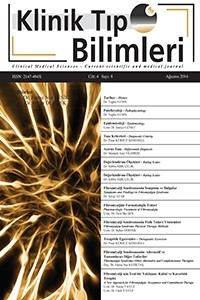Kimde Sekonder Hipertansiyon Aramalıyım?
ÖzSekonder hipertansiyon düzeltilebilme potansiyeli olan bir nedene bağlı hipertansiyon formudur. Sekonder etyolojiler semptomlar, fizik muayene veya laboratuvar anormallikleri sonrasında düşünülür. Sekonder hipertansiyon dirençli hipertansiyon ve erken yada geç başlangıçlı hipertansiyon varlığında da akla gelmelidir. Taşıdığı yüksekkardiyovasküler risk nedeniyle özel tanı ve tedavilerin uygulanması önemlidir.
Anahtar Kelimeler:
sekonder hipertansiyon, yaş, dirençli hipertansiyon
Secondary Hypertension, Whom I should Investigate?
AbstractSecondary hypertension is a type of hypertension with an underlying, potentially correctable cause. Secondary etiology may be suggested by symptoms, physical examination or laboratory abnormalities. Secondary hypertension also should be consideredin patients with resistant hypertension, and early or late onset of hypertension. Due tohigher cardiovascular risk, this disorder requires special diagnosis and treatment.
Keywords:
secandary hypertension, age, resistant hypertension,
___
- Kaynaklar 1.Omura M, Saito J, Yamaguchi K, Kakuta Y, Nishikawa T. Prospec-tive study on the prevalence of secondary hypertension among hyper-tensive patients visiting a general outpatient clinic in Japan. Hyper-tens Res. 2004;27:193-202. 2.Rudnick KV, Sackett DL, Hirst S, Holmes C. Hypertension in a fa-mily practice. Can Med Assoc J. 1977;117:492-7. 3.A. John Camm, Thomas F. Luscher, Patrick W. Serruys. The ESCTextbook of Cardiovascular Medicine. Blackwell Publishing Ltd., Ox-ford.2006. 4.Chobanian AV, Bakris GL, Black HR, Cushman WC, Green LA, IzzoJL Jr, et al. The Seventh Report of the Joint National Committee onPrevention, Detection, Evaluation, and Treatment of High Blood Pres-sure: the JNC 7 report. JAMA. 2003;289:2560-72. 5.Kalra PA, Mamtora H, Holmes AM, Waldek S. Renovascular disea-se and renal complications of angiotensin-converting enzyme inhi-bitor therapy. Q J Med. 1990;77:1013-8. 6.van de Ven PJ, Beutler JJ, Kaatee R, Beek FJ, Mali WP, KoomansHA. Angiotensin converting enzyme inhibitor-induced renal dysfunc-tion in atherosclerotic renovascular disease. Kidney Int. 1998;53:986-93. 7.Aqel RA, Zoghbi GJ, Baldwin SA, Auda WSA, Calhoun DA, CoffeyCS, et al. Prevalence of renal artery stenosis in high risk veteransreferred to cardiac catheterization. J Hypertens 2003;21:1157-62. 8.National High Blood Pressure Education Program Working Groupon High Blood Pressure in Children and Adolescents. The fourth re-port on the diagnosis, evaluation, and treatment of high blood pres-sure in children and adolescents. Pediatrics. 2004;114(2 Suppl 4thReport):555-76. 9.Chiong JR, Aronow WS, Khan IA, Nair CK, Vijayaraghavan K, DartRa, et al. Seconadry hypertension: current diagnosis and treatment.Int J Cardiol 2008;124:6-21. 10.Brickner ME, Hillis LD, Lange RA. Congenital heart disease in adults.First of two parts. N Engl J Med. 2000;342(4):256-63. 11.Klein I, Danzi S. Thyroid disease and the heart. Circulation.2007;116:1725-35. 12.Prisant LM, Gujral JS, Mulloy AL. Hyperthyroidism: a secondarycause of isolated systolic hypertension. J Clin Hypertens (Greenwich).2006;8:596-9. 13.Mosso L, Carvajal C, Gonzales A, Barraza A, Avila F, Mntero J, etal. Primary aldosteronism and hypertensive disease. Hypertension2003;42:161-5. 14.Moser M, Setaro JF. Resistant or difficult-to-control hypertension.N Engl J Med. 2006;355:385-92. 15.Seiler L, Rump LC, Schulte-Mönting J, Slawik M, Borm K, Pavens-tädt H, et al. Diagnosis of primary aldosteronism: value of differentscreening parameters and influence of antihypertensive medication.Eur J Endocrinol. 2004;150:329-37. 16.Funder JW, Carey RM, Fardella C, Gomez-Sanchez CE, ManteroF, Stowasser M, et al. Case detection, diagnosis, and treatment ofpatients with primary aldosteronism: an endocrine society clinicalpractice guideline. J Clin Endocrinol Metab. 2008;93:3266-81. 17.Schwartz GL, Turner ST. Screening for primary aldosteronism in es-sential hypertension:diagnostic accuracy of the ratio plasma aldos-terone concentration to plasma renin activity. Clin Chemis2005;51:386-94. 18.Calhoun DA, Zaman MA, Nishizaka MK. Resistant hypertension. Currhypertens rep 2002;4:221-8. 19.Pacak K, Linehan WM, Eisenhofer G, Walther MM, Goldstein DS.Recent advances in genetics, diagnosis, localization, and treat-ment of pheochromocytoma. Ann Intern Med. 2001 Feb20;134(4):315-29.20.Adler JT, Meyer-Rochow GY, Chen H, Benn DE, Robinson BG, Sip-pel RS, et al. Pheocromocytoma: current approaches and future di-rections. Oncologist 2008;13:779-93. 21.Logan AG, Perlikowski SM, Mente A, Tisler A, Tkacova R, Nirou-mand M, et al. High prevalence of unrecognised sleep apnoea in drugresistant hypertension. J hypertens 2001;19:2271-7. 22.Lavie P, Hoffstein V. Sleep apnea syndrome: a possible contributingfactor to resistant. Sleep 2001;24:721. 23.Becker HF, Jerrentrup A, Ploch T, Grote L, Penzel T, Sullivan CE,et al. Effect of nasal continuous positive airway pressure treatmenton blood pressure in patients with obstructive sleep apneaa. Circu-lation 2003;107:68-73. 24.Norlela Sukor. Endocrine hypertension- Current understanding andcomprehensive management review. Eur J Int Med 2011;22:433-440.
- ISSN: 2147-494X
- Başlangıç: 2013
- Yayıncı: Selen Medya Yayıncılık Tanıtım ve Organizasyon Hizmetleri
Sayıdaki Diğer Makaleler
Çocuk ve Ergenlerde Hipertansiyon:Son Gelişmeler Işığında Tanı ve Tedavi?
Tedavide İdeal Kombinasyonlar: Kime? Hangi Kombinasyon?
Hipertansiyonda Akılcı İlaç Tedavisi
Tedavi Hedefleri: Ne Kadar Kabul Edilebilir?
“Hipertansiyon ve Egzersiz; İyi Ama Nasıl”
Sağlıklı Beslenme –Neleri Gözden Kaçırıyoruz?
Antihipertansif Tedavide Kalp Hızı:Dikkate Alınmalı Mı?
Obezite Epidemiyolojisi ve Korunma
Obezitede Diyetin Düzenlenmesi
